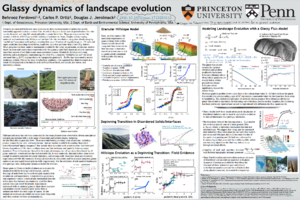2018 CSDMS meeting-066: Difference between revisions
(Created page with "{{CSDMS meeting personal information template-2018 |CSDMS meeting first name=Behrooz |CSDMS meeting last name=Ferdowsi |CSDMS meeting institute=Princeton University |CSDMS mee...") |
No edit summary |
||
| Line 33: | Line 33: | ||
{{CSDMS meeting abstract template 2018 | {{CSDMS meeting abstract template 2018 | ||
|CSDMS meeting abstract=Soil creeps imperceptibly downhill, but also fails catastrophically to create landslides. Despite the importance of these processes as hazards and in sculpting landscapes, there is no agreed upon model that captures the full range of behavior. Here we examine the granular origins of hillslope soil transport by Discrete Element Method simulations, and re-analysis of measurements in natural landscapes. We find creep for slopes below a critical gradient, where average particle velocity (sediment flux) increases exponentially with friction coefficient (gradient). At critical there is a continuous transition to a dense-granular flow rheology. Slow earthflows and landslides thus exhibit glassy dynamics characteristic of a wide range of disordered materials; they are described by a two-phase flux equation that emerges from grain-scale friction alone. This glassy model reproduces topographic profiles of natural hillslopes, showing its promise for predicting hillslope evolution over geologic timescales. | |CSDMS meeting abstract=Soil creeps imperceptibly downhill, but also fails catastrophically to create landslides. Despite the importance of these processes as hazards and in sculpting landscapes, there is no agreed upon model that captures the full range of behavior. Here we examine the granular origins of hillslope soil transport by Discrete Element Method simulations, and re-analysis of measurements in natural landscapes. We find creep for slopes below a critical gradient, where average particle velocity (sediment flux) increases exponentially with friction coefficient (gradient). At critical there is a continuous transition to a dense-granular flow rheology. Slow earthflows and landslides thus exhibit glassy dynamics characteristic of a wide range of disordered materials; they are described by a two-phase flux equation that emerges from grain-scale friction alone. This glassy model reproduces topographic profiles of natural hillslopes, showing its promise for predicting hillslope evolution over geologic timescales. | ||
|CSDMS meeting posterPDF=Ferdowsi_CSDMS_POSTER_May2018.pdf | |||
|CSDMS meeting posterPNG=Ferdowsi_CSDMS_POSTER_May2018.png | |||
}} | }} | ||
{{blank line template}} | {{blank line template}} | ||
Latest revision as of 19:41, 25 May 2018
Log in (or create account for non-CSDMS members)
Forgot username? Search or email:CSDMSweb@colorado.edu
Browse abstracts
Glassy dynamics of landscape evolution
Soil creeps imperceptibly downhill, but also fails catastrophically to create landslides. Despite the importance of these processes as hazards and in sculpting landscapes, there is no agreed upon model that captures the full range of behavior. Here we examine the granular origins of hillslope soil transport by Discrete Element Method simulations, and re-analysis of measurements in natural landscapes. We find creep for slopes below a critical gradient, where average particle velocity (sediment flux) increases exponentially with friction coefficient (gradient). At critical there is a continuous transition to a dense-granular flow rheology. Slow earthflows and landslides thus exhibit glassy dynamics characteristic of a wide range of disordered materials; they are described by a two-phase flux equation that emerges from grain-scale friction alone. This glassy model reproduces topographic profiles of natural hillslopes, showing its promise for predicting hillslope evolution over geologic timescales.

